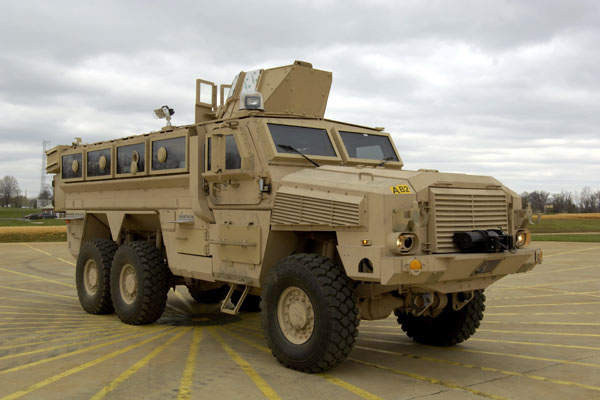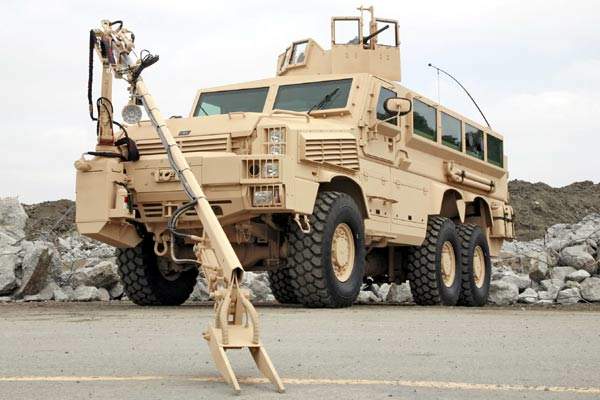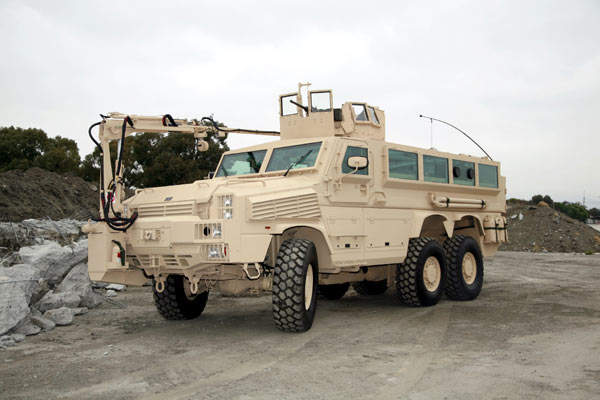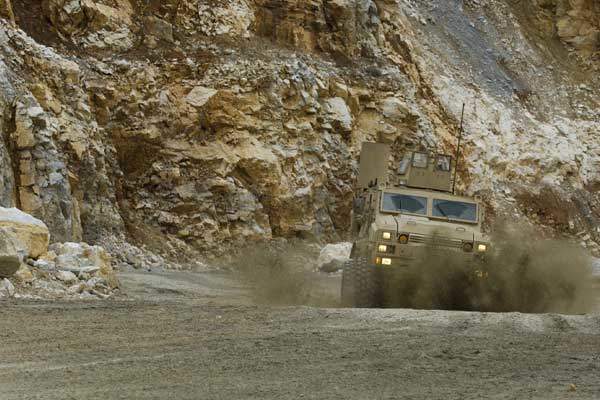The RG33 is a family of mine-protected vehicles manufactured by BAE Systems. The RG33 4×4 and 6×6 are in production in the United States for the US Marine Corps mine-resistant ambush-protected (MRAP) vehicle programme. BAE Systems manufactures three of the US Marine Corps’ five variants of MRAP vehicles: the Caiman, the RG31 and the RG33.
The RG33 is manufactured in several configurations including the category I 4×4, category II 6×6, the heavy armored ground ambulance (HAGA) and the special operations command (SOCOM) vehicle. The RG33 series is in the medium weight class, providing survivability, advanced mobility, mission flexibility, rapid availability and vehicle commonality.
RG33 MRAP vehicle orders and deliveries
The initial contract for the USMC was placed in January 2007 for two 4×4 and two 6×6 RG33 vehicles. In February 2007, the USMC ordered 15 RG33 category I 4×4 and 75 category II MRAP vehicles.
In June 2007, BAE Systems was awarded a contract for 425 category I and 16 category II. In October 2007, the USMC ordered 399 category II MRAP, 112 category II ambulances and 89 SOCOM vehicles.
In August 2008, the US Marine Corps placed a $43.5m contract with BAE Systems for 40 RG33 MRAP vehicles: 36 special operations command variants, two RG33 MRAP category II 6×6 variants, and two category II HAGAs. In June 2008, BAE Systems was awarded a $53m contract for 40 SOCOM MRAP vehicles.
In February 2010, the US Marine Corps placed a $90.6m contract for 58 SOCOM vehicles. BAE Systems received another $170m order for 32 SOCOM vehicles in August 2010.
By July 2010, BAE Systems had completed over 2,200 RG33 vehicles for the US Army and Marine Corps.
In July 2011, the US Marine Corps placed multiple contracts totalling over $56m towards the delivery, upgrade and maintenance of the RG-33 family of vehicles.
The RG33 vehicle hull production is being carried out at BAE Systems’ York, Pennsylvania, facility and final assembly, integration, and test is carried out at the Letterkenny Army Depot (LEAD) in Chambersburg, Pennsylvania.
RG33 mine protection and survivability
RG33 series vehicles provide survivability against improvised explosive devices (IEDs), medium machine gun or small arms fire and mine blast protection at a level equal to or exceeding currently fielded mine-protected vehicles. The vehicle incorporates a monocoque V-shaped hull incorporating design features based on leveraging knowledge gained in recent and ongoing conflicts.
The crew and passenger survivability features include blast-resistant seats, transparent armour and protected interior stations. The vehicles can be equipped with additional armour packages.
Mobility
The RG33 series provides a large volume under armour to provide maximum troop-carrying capacity and to give troops the optimum manoeuvrability on the battlefield.
The platform’s advanced power train enables the vehicle to safely operate on any terrain and also to maintain pace with other high-speed combat vehicles. They have the speed and manoeuvrability to keep pace with the Stryker brigade combat team.
The power train is of sufficient capacity to allow upgrades and enhancements.
Both 4×4 and 6×6 vehicles are transportable by land, rail, sea and air.
Mission flexibility
The RG33 series provides flexibility by being configurable for missions such as infantry carrier, ambulance, command and control, convoy escort, explosive ordnance disposal and other roles and is recoverable by another RG33. The vehicle features on-board exportable power for a range of mission equipment such as command, control, communications, computers and information (C4I).
Commonality
The RG33 series of vehicles (4×4 and 6×6) have a commonality of parts of more than 90%, which provides saving in acquisition costs, operations, maintenance and program management.
RG33 6×6 mine-protected vehicle
The RG33 6×6 is a proven, survivable, blast-protected vehicle that can operate in explosive hazardous environments, carrying out missions such as route and area clearance, explosive hazards reconnaissance and explosive ordnance disposal operations. Troop-friendly features include large ballistic windows, a rear ramp for rapid entry and exit of the crew and robotic systems. A common weapon ring may be mounted to the rooftop for integration of a wide variety of weapon systems, to include the army’s gunner protection kit.
The modular RG33 6×6 vehicle is mission adaptable, with roles including infantry carrier, explosive ordnance disposal (EOD), convoy protection, weapons carrier, utility, command and control, communications shelter and ambulance.
Optional equipment for the RG33 6×6 includes add-on armour, hydraulic rear ramp, medical equipment, explosives ordnance disposal arm, 6kW auxiliary power unit, 120/240 AC import / export power, secondary battery suite, thermal driver’s vision enhancer, tail-light camera, central tire inflation system, transparent armour gun shield and a remote weapons station.
RG33 4 × 4 mine-protected vehicle
The RG33 4×4 mine protected vehicle transports up to eight personnel with the same troop-friendly features as the 6×6 version.
A common weapon ring is mounted to the rooftop for integration of a wide variety of weapon systems, including the army’s gunner protection kit, or remote weapon systems.
The modularity allows the vehicle to be adaptable for multiple missions including reconnaissance, tube-launched, optically tracked, wire-guided weapon systems (TOW ) / improved target acquisition system (ITAS) / long-range acquisition / surveillance system (LRAS), weapons carrier, utility and convoy protection.
Optional equipment is the same as for the 6×6, with the exception of the ordnance disposal arm.
Mine-resistant recovery and maintenance vehicle (MRRMV)
A new variant of the RG33 is the mine-resistant recovery and maintenance vehicle (MRRMV) for retrieval and repair of disabled mine-resistant ambush-protected vehicles, medium mine-protected vehicles and other medium tactical vehicles in combat situations.
The MRRMV has a two-man crew and carries equipment and spare parts to conduct on-site vehicle repairs. The vehicle supports field maintenance tasks that require lifting, welding, cutting and heating and has the capacity to carry two recovered crew and combat spares. The MRRMV was first shown at the Association of the US Army’s (AUSA) winter symposium in Ft Lauderdale, Florida, in February 2008.
The Global Armoured Vehicles and Counter-IED Vehicles Market 2011-2021
This project forms part of our recent analysis and forecasts of the global armoured vehicles and counter-IED vehicles market available from our business information platform Strategic Defence Intelligence. For more information click here or contact us: EMEA: +44 20 7936 6783; Americas: +1 415 439 4914; Asia Pacific: +61 2 9947 9709 or via email.








